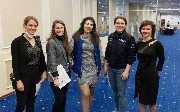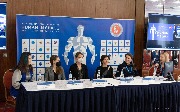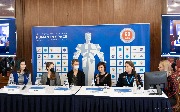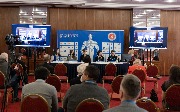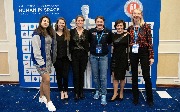MAI student took part in a round table with famous women astronauts
Vera Mymrina, a third-year student of the MAI Aerospace Institute No. 6, has participated in a round table discussion on the problems of involving women in space research and the rocket and space industry held as part of the XXIII International Symposium "Human in Space". The Symposium was organized by the Institute of Biomedical Problems of the Russian Academy of Sciences on the eve of International Cosmonautics Day.
Loral O'Hara, American oceanographer, engineer, and NASA astronaut; Grier Wilt, NASA Deputy Director of NASA Operations in Russia; Russian cosmonaut and test pilot of the Yuri Gagarin Space Center research institute and the only woman in the cosmonaut squad of Roscosmos since September 2016, Anna Kikina, and, finally, Senior Researcher of the Institute of Medical and Biological Problems of RAS, responsible for the "Cardiovector" scientific experiment on the ISS and Moon 2015 flight commander, Elena Luchitskaya, were invited to take part in the Round Table.
The round table "Women in space" was dedicated to the problems of attracting women to space research and the rocket and space industry. The participants discussed their experience of working in mixed and single-sex crews, the impact of physiological differences between men and women on work processes in space, and how differences in physical strength are levelled with advances in technology and microgravity conditions.
Tell us about your experience in space missions. What differences between men and women are in the requirements for eligibility?
"Until 2012, I was just an engineer and never even considered the prospect of becoming an astronaut. But in 2012, my life changed abruptly when I was invited to join the crew - that's when I realized that this is the path I have to take," said Anna Kikina.
Elena explained why she chose flying over science: "I'm interested in being an object of research - I love exploring my body's capabilities, challenging myself, and having strong experiences. In the end, I am not at all afraid of the tests that our doctors perform, because I fully trust them”.
Did you initially want to work in the space field or was it just a matter of chance?
"As a child, I was a Star Wars fan, attracted by the technical challenges. Today, I approach my work with great enthusiasm. I am very passionate about what I am doing. I believe that the times are changing for women. Have been asked about how it is like to work in this field as a woman more times than I have actually faced gender-based problems," Grier shared with the audience.
Loral, on the other hand, said that she began her career studying underwater robots but had always dreamed of working for NASA: “The whole world can be involved in its projects. Therefore, I appreciate this unique aspect of international cooperation and partnership”.
Vera Mymrina, an MAI student, noted that since childhood, she had dreamed of becoming an astronaut, but due to her leg injury, she decided to contribute to the development of space by working on Earth.
"I am interested in this field and want to further develop in this direction and I feel the support from teachers, NIRS, and my classmates. The results of my research work and participation in the conference give me the strength and motivation to pursue science further. I am currently involved in a project to build a biosatellite to study the effects of deep space on living organisms. In particular, we are interested in DNA mutations in Drosophila. A team of five people is working on this project, two of them are 3rd-year students. I have also written scientific articles on topics such as "protection of the ISS from microorganisms", "analysis of modern alternative rocket fuels", "public view on genome editing" and others," shared Vera.
The anthropometric parameters of men and women are different, but the requirements for astronauts are the same for all. How do you manage to be on an equal footing?
"I have been a member of mixed crews. On Earth, I prepare for a mission on an equal footing with men and I do not see much difference between men and women. Crew members share one important goal that blurs all differences - to complete the mission," replied Anna Kikina.
"I have worked in mixed crews as well as female crews. We are all different, and we are not only different in terms of gender - we have different cultures from different parts of the world. Still, we manage to find ways to communicate and work together effectively, and there are many benefits to working in such a diverse team," said Loral O'Hara, who joined the discussion. "The requirements for men and women are the same. Of course, physical stamina is taken into account in the selection process, but that alone is not enough. An astronaut has to have a whole set of qualities and skills and knowledge to do a fairly demanding job - he has to be competent, have a flexible mind to find ways to adapt to changing conditions. We had a whole palette of different specialists working on our crew: pilots, scientists, engineers, doctors - each of them brought their unique knowledge and skills", Loral added.
"The determining factors in selecting crew members are a person's professional skills and qualities, not gender," summarised Elena Luchitskaya.
On Earth, there are many women in leadership positions, even in male crews. However, why is such a rarity on the ISS?
"NASA uses rockets designed back in 1991. Back then, most rockets were designed 'for men' and were not adapted for women. With today's realities, we need to build more 'inclusive' rockets that are optimized for smaller individuals, most of whom are women, and indeed for people of completely different proportions," replied Grier Wilt.
"We are all unique, which means that equipment must be versatile and usable for everyone," agreed Anna Kikina, her colleague.
Anna encouraged the audience by mentioning the successful cases of women who have become crew chiefs: "Women have undoubtedly managed to achieve leadership positions on the ISS. For example, Eileen Collins commanded the very demanding mission STS-115 in 2005 and Peggy Whitson became mission commander seven times. They both had a military background. Remember, no one, male or female, can become a flight commander right away - everything comes with time, and the selection for a flight commander position is based purely on an assessment of the candidates' professional experience.
How do you manage to combine a huge amount of training and work with your usual household activities? Moreover, at the same time remain a charming girl?
Loral talked about her perspective on maintaining a balance between her personal life and her astronaut career: "As female astronauts, we face some biological challenges because a pregnant or breastfeeding woman cannot work in space. Fortunately, we openly discuss such issues at NASA, and this important stage in women's lives is all taken into account."
Anna Kikina pointed out that there is no one-size-fits-all solution. The approach to balancing is very individual and depends on the person. Elena, on the other hand, described her family's attitude to her work in just one phrase: "When my son was asked what he thought about his mother going into space soon, he simply said: «I'm very excited!».
Even though there are fewer and fewer professions forbidden for women every year, young girls are hesitant and afraid to follow their dreams. What do you think this has to do with? What advice would you give to girls who dream of conquering space?
"Everyone has doubts sometimes, regardless of gender or age. I, too, sometimes have doubts about my abilities, and this is normal. In my opinion, to achieve your goals, it is important to find a good mentor or support group, people who can give the right advice in time or even open up new opportunities. Also, find a positive image that you aspire to, that inspires you to succeed and make your dreams come true," Loral, advised.
MAI student told the participants, who were her role models: "For me, my role model is Jennifer Doudna, the woman who recently won the Nobel Prize in Chemistry for developing a method of genome editing."
"Dreams and ambitions are one thing, real effort to achieve them are quite another. You have to be willing to work hard every day to get closer to your goal," Elena replied.
"My main goal is to be happy. To be happy, you need to respect and love yourself and the society you live in; you need to believe in yourself, do what you love, and constantly learn. Eventually, different doors will open in front of you and you will be able to see your way," Anna shared her approach.
What measures would you suggest we take globally to attract girls into the field?
"We need to work on erasing culturally or historically conditioned barriers at different stages of women's careers in this field," Loral O’Hara claimed.
Grier Wilt added: "I see a positive dynamic in attitudes towards women in our field. However, sometimes women behave more modestly and are not active enough. Therefore, I encourage men to always invite women to the discussion table, discuss with them, give them a voice, and encourage them to be more courageous and active. In this way, we will get more opinions and ideas, and therefore a better chance of finding solutions to different problems. I would like to see more global awareness of the fact that women, due to their relative diminutiveness, are better suited for long-term missions than large men."
"As a science girl, I urge everyone to boldly pursue their dreams. Every girl can achieve whatever she wants," the MAI student recapitulated.
Currently, of the 565 astronauts and astronauts who have flown in space, only 64 are women. 50 from the USA, 4 from the USSR and Russia, 2 from Canada, China, and Japan, as well as one from England, France, Korea, and Italy. With big plans for the moon and Mars, it is clear that without women, humanity cannot be represented beyond Earth.
The video recording of the round table “Women in space” is available online.
